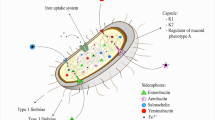Abstract
Vibrio cholerae, the causing agent of cholera is still a major health challenge in most of the developing countries. In this study, V. cholerae strains collected from different cholera outbreaks in India over a period of past 7 years were found to have various toxigenic, pathogenic and regulatory genes viz. ctxAB, zot, tcp, hlyA, ace, ompU, ompW, rfbO1, toxT and toxR. The biotype specific genes rstR and rtxC revealed the El Tor biotype in majority of the isolates. However, variants among the isolates were found having genotype of both the biotypes. Sequencing of ctxB gene revealed the presence of altered ctxB of classical biotype with additional variations in isolates of 2007. Mismatch amplification mutation assay PCR also confirmed the isolates belonging to classical biotype. Antibiogram of the isolates revealed resistance for nalidixic acid, co-trimoxazole, streptomycin, and polymyxin B and susceptibility for tetracycline among most of the isolates from India. However, V. cholerae isolates from a recent outbreak in Eastern India were resistant to tetracycline. The study corroborated the continuous emergence and wide-spread of multidrug resistant El Tor variant strains in the Indian subcontinent.
Similar content being viewed by others
References
WHO (2012) Cholera, 2011. Wkly Epidemiol Rec 87(31/32):289–304
Safa A, Sultana J, Dac Cam P, Mwansa JC, Kong RY (2008) Vibrio cholerae O1 hybrid El Tor strains, Asia and Africa. Emerg Infect Dis 14(6):987–988
Goel AK, Jain M, Kumar P, Bhadauria S, Kmboj DV, Singh L (2008) A new variant of Vibrio cholerae O1 El Tor causing cholera in India. J Infect 57(3):280–281. doi:10.1016/j.jinf.2008.06.015
Chin CS, Sorenson J, Harris JB, Robins WP, Charles RC, Jean-Charles RR, Bullard J, Webster DR, Kasarskis A, Peluso P, Paxinos EE, Yamaichi Y, Calderwood SB, Mekalanos JJ, Schadt EE, Waldor MK (2011) The origin of the Haitian cholera outbreak strain. N Engl J Med 364(1):33–42. doi:10.1056/NEJMoa1012928
Goel AK, Jiang SC (2010) Genetic determinants of virulence, antibiogram and altered biotype among the Vibrio cholerae O1 isolates from different cholera outbreaks in India. Infect Genet Evol 10(6):815–819. doi:10.1016/j.meegid.2009.06.022
Jain M, Kumar P, Goel AK, Kamboj DV, Singh L (2008) Class 1 integrons and SXT elements conferring multidrug resistance in Vibrio cholerae O1 strains associated with a recent large cholera outbreak in Orissa, Eastern India. Int J Antimicrob Agents 32(5):459–460. doi:10.1016/j.ijantimicag.2008.05.003
Tamrakar AK, Goel AK, Kamboj DV, Singh L (2006) Surveillance methodology for Vibrio cholerae in environmental samples. Int J Environ Health Res 16(4):305–312. doi:10.1080/09603120600734303
Kumar P, Jain M, Goel AK, Bhadauria S, Sharma SK, Kamboj DV, Singh L, Ramamurthy T, Nair GB (2009) A large cholera outbreak due to a new cholera toxin variant of the Vibrio cholerae O1 El Tor biotype in Orissa, Eastern India. J Med Microbiol 58(Pt 2):234–238. doi:10.1099/jmm.0.002089-0
Bhattacharya T, Chatterjee S, Maiti D, Bhadra RK, Takeda Y, Nair GB, Nandy RK (2006) Molecular analysis of the rstR and orfU genes of the CTX prophages integrated in the small chromosomes of environmental Vibrio cholerae non-O1, non-O139 strains. Environ Microbiol 8(3):526–634
Morita M, Ohnishi M, Arakawa E, Bhuiyan NA, Nusrin S, Alam M, Siddique AK, Qadri F, Izumiya H, Nair GB, Watanabe H (2008) Development and validation of a mismatch amplification mutation PCR assay to monitor the dissemination of an emerging variant of Vibrio cholerae O1 biotype El Tor. Microbiol Immunol 52(6):314–317
Nandi B, Nandy RK, Mukhopadhyay S, Nair GB, Shimada T, Ghose AC (2000) Rapid method for species-specific identification of Vibrio cholerae using primers targeted to the gene of outer membrane protein OmpW. J Clin Microbiol 38(11):4145–4151
Abdallah F, Lagha R, Ellafi A, Namane A, Rousselle J-C, Lenormand P, Kallel H (2012) Identification of outer membrane proteins altered in response to UVC-radiation in Vibrio parahaemolyticus and Vibrio alginolyticus. Indian J Microbiol 52(4):660–665. doi:10.1007/s12088-012-0299-2
Kaper JB, Morris JG Jr, Levine MM (1995) Cholera. Clin Microbiol Rev 8(1):48–86
Waldor MK, Mekalanos JJ (1996) Lysogenic conversion by a filamentous phage encoding cholera toxin. Science 272(5270):1910–1914
Goel AK, Jain M, Kumar P, Jiang SC (2010) Molecular characterization of Vibrio cholerae outbreak strains with altered El Tor biotype from southern India. World J Microbiol Biotechnol 26(2):281–287. doi:10.1007/s11274-009-0171-7
Tamrakar AK, Jain M, Goel AK, Kamboj DV, Singh L (2009) Characterization of Vibrio cholerae from deep ground water in a cholera endemic area in Central India. Indian J Microbiol 49(3):271–275. doi:10.1007/s12088-009-0043-8
Goel AK, Bhadauria S, Kumar P, Kamboj DV, Singh L (2007) Semi-nested polymerase chain reaction for detection of toxigenic Vibrio cholerae from environmental water samples. Indian J Microbiol 47(3):207–211. doi:10.1007/s12088-007-0041-7
Goel AK, Jain M, Kumar P, Sarguna P, Bai M, Ghosh N, Gopalan N (2011) Molecular characterization reveals involvement of altered El Tor biotype Vibrio cholerae O1 strains in cholera outbreak at Hyderabad, India. J Microbiol 49(2):280–284. doi:10.1007/s12275-011-0317-9
Kimsey HH, Nair GB, Ghosh A, Waldor MK (1998) Diverse CTXphis and evolution of new pathogenic Vibrio cholerae. Lancet 352(9126):457–458
Nair GB, Qadri F, Holmgren J, Svennerholm AM, Safa A, Bhuiyan NA, Ahmad QS, Faruque SM, Faruque AS, Takeda Y, Sack DA (2006) Cholera due to altered El Tor strains of Vibrio cholerae O1 in Bangladesh. J Clin Microbiol 44(11):4211–4213
Joshi RM, Albert MJ (2009) Hybrid El Tor Vibrio cholerae O1, Kuwait. Emerg Infect Dis 15:1879–1880
Ghosh-Banerjee J, Senoh M, Takahashi T, Hamabata T, Barman S, Koley H, Mukhopadhyay AK, Ramamurthy T, Chatterjee S, Asakura M, Yamasaki S, Nair GB, Takeda Y (2010) Cholera toxin production by the El Tor variant of Vibrio cholerae O1 compared to prototype El Tor and classical biotypes. J Clin Microbiol 48(11):4283–4286. doi:10.1128/JCM.00799-10
Acknowledgments
Authors are thankful to Director, DRDE, Gwalior for providing necessary facilities and funds for the work.
Author information
Authors and Affiliations
Corresponding author
Rights and permissions
About this article
Cite this article
Jain, M., Kushwah, K.S., Kumar, P. et al. Molecular Characterization of Vibrio cholerae O1 Reveals Continuous Evolution of Its New Variants in India. Indian J Microbiol 53, 137–141 (2013). https://doi.org/10.1007/s12088-013-0372-5
Received:
Accepted:
Published:
Issue Date:
DOI: https://doi.org/10.1007/s12088-013-0372-5




